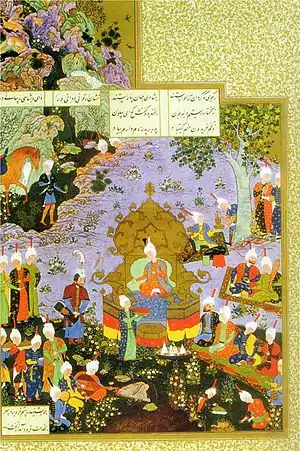Div-e Sepid
In the Persian epic of Shahnameh Div-e Sepid (Persian: دیو سپید, lit. White Demon), is the chieftain of the Divs (demons) of Mazandaran. He is a huge being. He possesses great physical strength and is skilled in sorcery and necromancy. He destroys the army of Kay Kavus by conjuring a dark storm of hail, boulders, and tree trunks using his magical skills. He then captures Kay Kavus, his commanders, and paladins; blinds them, and imprisons them in a dungeon. The greatest Persian mythical hero Rostam undertakes his "Seven Labors" to free his sovereign. At the end, Rostam slays Div-e Sepid and uses his heart and blood to cure the blindness of the king and the captured Persian heroes. Rostam also takes the Div's head as a helmet and is often pictured wearing it.[1]
_-_Walters_W60091A_(cropped).jpg.webp)
In the Shabrangnama
In the Shabrangnama it is revealed that the white demon sired a son.[2]
Alternative views
It is written in the Journal of the Royal Central Asian Society that the struggle between Rostam and the white demon represents a struggle between Iranians and invaders from the north, from the Caspian provinces.[3]
The Div-e Sepid is believed by Joseph J. Reed to have been a northern prince.[4] Warner believes that he is a personification of the Mazandaranians, who by their climate are an unhealthy pale colour.[5] Some scholars hold the opinion that these divs of Mazandaran are merely wild people of the forest.[6] Others are of the opinion that they are a group of enemy kings of ancient Mazandaran (which might have been different from its modern location) and Tabaristan.[7] Alexander Krappe theorized that Ahriman himself was believed to have white skin.[8] P. Molesworth Sykes believes that the name "White Div" represents a white nation.[9]
According to one source Zal spoke of the horrid race of white-skinned people.[10] This however contradicts with the fact that Zal was an albino himself. Zal means albino in Persian language. [11]
References
- Vesta Sarkhosh Curtis (1993). Persian Myths. University of Texas Press. ISBN 0-292-71158-1.
- Shahnama Studies II : the Reception of Firdausi's Shahnama. Melville, C. P. (Charles Peter), 1951-, Van den Berg, Gabrielle Rachel, 1967-. Leiden: Brill. 2012. ISBN 9789004228634. OCLC 808441521.CS1 maint: others (link)
- Journal of the Royal Central Asian Society By Royal Central Asian Society
- P. 23 Outlines of universal history: in three parts; with a copious index to each part, showing the correct mode of pronouncing every name mentioned ... by Joseph J Reed
- P. 507 Encyclopedia of Religion and Ethics Part 16 By James Hastings
- The Wild Rue: A Study of Muhammadan Magic and Folklore in Iran By Bess Allen Donaldson
- P. 120 World Of Myths By Felipe Fernández-Armesto
- Alexander H. Krappe 'Albinos and Albinism in Iranian Tradition' Folklore Vol. 55, No. 4 (December 1944) pp. 170-4
- P. 137 A History of Persia By Percy Molesworth Sykes
- P. 121 Myths of the Hero: With 105 Illustrations by Norma Lorre Goodrich
- Encyclopædia Iranica, "Zal", E. Yarshater
External links
| Wikimedia Commons has media related to Div-e-Sepid. |


.png.webp)